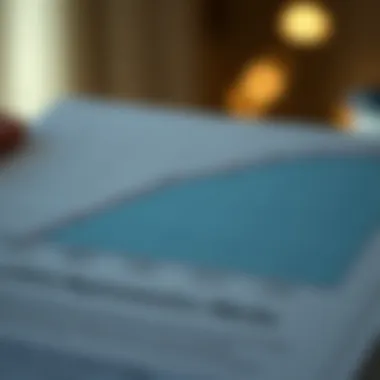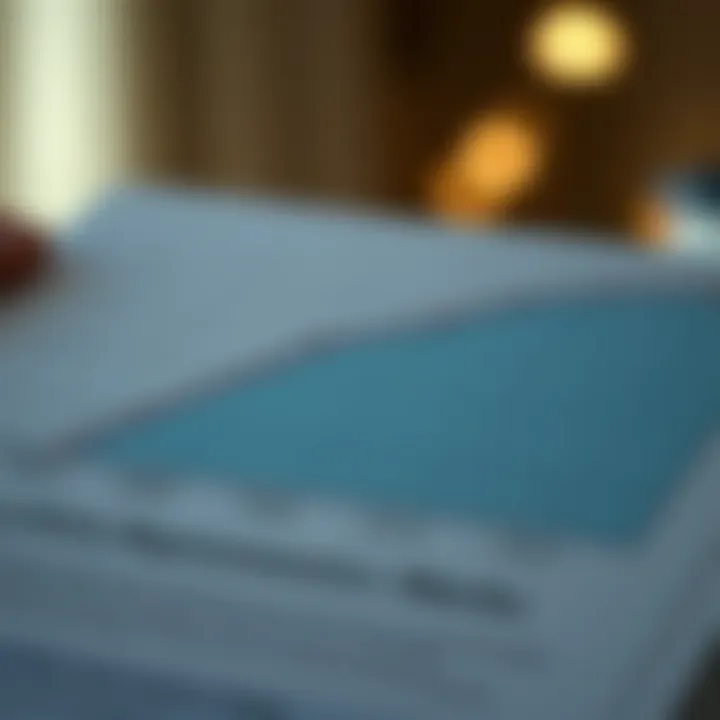How Repossession Affects Your Credit Report


Intro
Repossession can strike fear in the heart of any borrower. It feels like a punch to the gut and, most importantly, can leave a lasting mark on your credit report. When you face repossession, understanding its impact is crucial for your financial future. Delving into how repossession shows up on your credit report and what you can do to mitigate its effects can not only help you regain control but also empower you in your financial decisions.
A repossession occurs when a lender takes back an asset, such as a car, due to the borrower's failure to keep up with payment obligations. This action triggers a series of events that can wreak havoc on your credit score. For beginners and seasoned investors alike, grasping the nuances behind this process is essential if one aims to navigate the financial landscape effectively.
Understanding credit reports is a game-changer. These documents are not merely a collection of numbers; they provide insights into your borrowing habits and payment history. A repossession entry signals potential risk to future creditors, ultimately affecting your ability to secure new loans, mortgages, or even credit cards. It's vital to dissect the timeline of how long a repossession can linger on your report, as this ultimately influences your creditworthiness.
In the following sections, we will explore the terminology associated with repossession and credit scores. We'll also tackle expert insights and the best strategies for recovery. The knowledge you gain here can empower you to take concrete steps toward rebuilding your financial health. With that said, let’s jump into the nitty-gritty details!
The Basics of Repossession
Understanding the basics of repossession is crucial for anyone navigating financial waters. Repossession can be a major event in a person’s life, significantly affecting both their current standing and future opportunities. This section dives into what repossession really means and the reasons it occurs, helping readers appreciate the broader implications for their credit reports and financial health.
Definition of Repossession
Repossession refers to the process where lenders reclaim property or assets due to non-payment of a loan. This practice typically affects assets such as vehicles, homes, or other financed goods. When a borrower defaults, or even misses several payments, the lender has the right to take back their property, often without court involvement.
The core characteristic of repossession is that it signifies a breach of the loan agreement. Once the lender retrieves their property, it is often sold to mitigate the financial loss from the unpaid debt. For many, repossession is not just about losing an asset; it’s also a personal setback that can reverberate through other aspects of their lives, particularly their credit history.
Reasons for Repossession
Repossession can occur for various reasons, each with its own unique circumstances.
Failure to make payments
One obvious reason for repossession is the failure to make payments. When a borrower stops or falls behind on their loan obligations, the lender may take action, initiating the repossession process. The unfortunate reality is that many individuals underestimate the importance of consistent payments. A single missed payment can lead to a decent-sized snowball effect, pushing your financial standing downhill.
The key characteristic here is that financial responsibilities must be taken seriously. Failing to make payments often reflects broader issues, such as job loss or unplanned expenses. This aspect is vital because it underlines the necessity of budgeting carefully and maintaining a safety net for unforeseen circumstances.
Loan default scenarios
Loan default scenarios come into play when a borrower doesn’t meet the terms of the loan altogether. Defaulting on a loan, whether due to prolonged non-payment or not adhering to the agreed-upon conditions, inherently leads to repossession. What’s essential to grasp about this is that defaulting doesn’t just happen overnight; it usually unfolds over time, often accompanied by numerous late fees and penalties.
Another striking feature of loan defaults is that it can dramatically affect your credit score. When lenders report such defaults to credit agencies, it results in a tarnished credit report, making future financial endeavors increasingly challenging. Such a course of events is integral to understanding how repossession fits into your overall financial landscape.
Voluntary vs. involuntary repossession
There’s a notable difference between voluntary and involuntary repossession, which often confuses people. Involuntary repossession occurs when a lender seizes an asset without consent from the borrower. This scenario is generally the outcome of missed payments or defaults. Conversely, voluntary repossession allows borrowers to return the asset to the lender willingly, often as a result of recognizing they can no longer make the payments.
The benefit of voluntary repossession is typically a smoother transition, where borrowers can mitigate some damages to their credit report by proactively resolving their financial obligations. However, even in this scenario, the drawback remains; the repossession still negatively impacts credit ratings. This comparison plays a crucial role in determining how individuals may approach their financial strategies going forward.
By comprehending these foundational elements, readers can better prepare themselves and take appropriate actions to safeguard their financial future.
Understanding Credit Reports
Understanding credit reports is crucial for anyone who wishes to navigate the financial landscape wisely, especially after an event like repossession. The relevance of credit reports cannot be emphasized enough; they serve as a window into one's financial history and integrity, influencing lending decisions, rental agreements, and sometimes even job opportunities. Not to mention, credit reports encapsulate a trail of how responsibly someone manages their finances.
Components of a Credit Report
Credit reports contain several key elements that reflect a person's borrowing and repayment history:
Personal Information
Personal information forms the bedrock of a credit report. It's where your name, address, Social Security number, and date of birth reside. This information is paramount in verifying your identity. One striking aspect of personal information is that it tends to remain constant over time, providing a stable reference point for lenders. However, incorrect details—like a misspelled name—can lead to confusion or even fraud. Maintaining accurate personal information is vital.
Credit Accounts
Credit accounts account for the bulk of the data in a credit report and illustrate your credit behaviors over time. These accounts include credit cards, mortgages, and personal loans. A major character of credit accounts is the payment history reflected here; it's a clear indicator of whether you’ve been punctual or consistently late with payments. The unique feature of having multiple credit accounts is that they can bolster your credit score if managed wisely. Just remember, though, too many accounts opened in a short span can appear reckless to lenders.


Inquiries and Public Records
Inquiries and public records reflect external factors that might affect your creditworthiness. Inquiries are categorized into hard and soft pulls; hard inquiries typically occur when you apply for new credit, while soft pulls might happen during pre-approval checks. A key characteristic here is that too many hard inquiries can dent your credit score, thinking it shows that you are in a tight financial spot or looking excessively for credit. Public records, on the other hand, include bankruptcy filings or tax liens which can severely tarnish your credit. It’s evident that while inquiries can be minor speed bumps, public records are significant hurdles, both influencing how your credit is viewed by potential lenders.
Role of Credit Bureau Agencies
Credit bureaus are the custodians of the information contained within credit reports. Their role cannot be understated, as they gather data from various lenders and compile it into consumer reports.
Leading Credit Bureaus
In the realm of credit reporting, three bureaus stand above the rest: Experian, TransUnion, and Equifax. These leading credit bureaus each have their unique methodologies for data collection and scoring. Generally, they are seen as pillars of reliability within the financial ecosystem. However, discrepancies can sometimes arise between the reports generated by different bureaus, leading to confusion for consumers. This variance highlights the need for individuals to check each bureau's report regularly for accuracy.
How Reports are Generated
Reports are generated through a meticulous process that collects data from lenders and financial institutions. The key characteristic of this system is its reliance on information shared voluntarily by creditors. While this has its benefits—ensuring comprehensive reporting—it also opens the door for errors if lenders fail to report certain transactions. Thus, understanding how these reports are created allows individuals to better scrutinize their reports and identify any inconsistencies.
Consumer Rights
Consumer rights form a foundational aspect of understanding credit reports. Under federal law, individuals are entitled to access their credit reports annually at no cost, which is a beneficial feature for anyone wishing to stay informed. Additionally, consumers have the right to dispute inaccuracies found within their reports. This unique feature supports financial fairness but requires individuals to be proactive in reviewing their credit. Understanding these rights empowers consumers to take charge of their credit health and pursue any necessary corrections.
Remember: Knowledge is power. Familiarizing yourself with all aspects of your credit report can turn potential pitfalls into manageable hurdles on your path to financial recovery.
Duration of Repossession on Credit Reports
Understanding how long repossession affects credit reports is crucial for anyone grappling with this financial event. It isn't just about the immediate emotional aftermath; it’s about long-term financial implications. The presence of a repossession on a credit report can restrict future borrowing options and can ultimately lead to higher interest rates. When individuals grasp how long these entries stay on their records, they can better navigate the recovery process and plan their financial future accordingly.
Typical Timeframes
Standard seven-year mark
Most people are familiar with the standard that marks a repossession on a credit report for seven years. This seven-year timeframe is significant because it serves as a benchmark for much of the credit scoring process. Once a repossession occurs, its mark is a glaring red flag for lenders, often leading to a considerable drop in credit scores. This period is relatively uniform across many financial institutions and reflects a specific aspect of credit reporting practices.
The key characteristic of this seven-year mark is predictability. Borrowers know that after this period, the repossession will be removed, which can pave the way for better credit opportunities. It's a bit like a timer ticking down; knowing when the slate will be wiped clean is motivating. However, one critical feature of this timeframe is that it doesn't guarantee immediate recovery after the seven years. Borrowers must still rebuild their creditworthiness through responsible financial behaviors.
On the other hand, while the duration is clear, the eventual recovery can be slow and requires consistent effort. Patience becomes a virtue here, as many realize that simply waiting for the clock to wind down isn't enough; proactive measures are vital.
Factors affecting duration
While the standard seven-year mark is the general rule, specific factors affecting duration can make the landscape a bit murky. These factors include how the repossession was processed, whether it concluded a legal process, or if the debtor took any action that could alter their credit report. If a lender decides to sell the debt to a recovery agency, for instance, it can complicate how and when the repossession impacts a credit report.
Another key element to consider is state regulations—some states have laws that can influence the reporting of such events. For example, if an individual settles with the lender before the repossession marks hit the seven-year mark, they could potentially change how long it appears on their report. This introduces a layer of complexity and underscores the importance of understanding local regulations.
Some may argue that these variations offer flexibility; however, navigating through them can be daunting. Individuals hoping to mitigate the impact of repossession must stay informed and proactive as differences in laws and processes can indeed help shape their journey to recovery.
State Regulations and Variations
Repossession and its impact on credit reports can vary significantly based on state regulations. Each state has its own set of rules concerning repossession and credit reporting, making it crucial to understand local laws surrounding these issues. Some states may allow for longer reporting periods, while others may have protective measures for debtors.
Understanding these regulations provides valuable insight for those in challenging financial situations. It’s important for individuals to check their specific state laws, perhaps consulting with a financial advisor or exploring resources available through local government websites or consumer protection agencies such as Consumer Finance Protection Bureau.
The diversity of state regulations is significant and emphasizes that there's no one-size-fits-all approach to credit recovery post-repossession. Tailoring strategies based on local rules can lead to better outcomes for those looking to rebuild their lives after financial setbacks.
The Consequences of Repossession on Credit Score
Repossession can leave a mark not only on one’s property but also on one's financial future. When a debtor fails to uphold their agreement, and their asset is taken back, it sets off a chain reaction that directly impacts their credit score. Understanding these consequences becomes essential. The sooner one acknowledges the implications, the better equipped they will be to manage their finances post-repossession.
Immediate Impact on Credit Score
The immediate aftermath of a repossession is often a turbulent period filled with uncertainties. One of the first repercussions is a noticeable dip in the credit score. Credit scoring plays a pivotal role in determining how financial institutions evaluate potential borrowers. Significant alterations to this score can make financial recovery considerably more challenging.
Scoring models


Credit scoring models are tools used by lenders to assess an individual’s creditworthiness. There are a few scoring models, the most prominent being FICO and VantageScore. The scoring algorithms rely heavily on a person's payment history, credit utilization, and length of credit accounts, among other factors.
FICO, in particular, is widely regarded because it provides a comprehensive view of a borrower’s past behavior. The interesting part is that repossessions play a crucial role in shaping these scores. When a repossession is reported, it can lead to substantial drops in credit scores, sometimes by more than a hundred points. This serves as a harsh reminder of the importance of maintaining good payment habits.
Typical score decreases
Post-repossession, the decrease in credit scores can range widely depending on individual circumstances. Typical score decreases often fall between 100 to 300 points. This dramatic reduction highlights how punitive the system can feel. It is important to recognize that these declines can ultimately restrict one's ability to access future loans or secure favorable interest rates.
However, it’s essential to note that while this immediate impact can be severe, it is temporary. With dedication and strategic financial management, individuals can work towards rebuilding their credit.
Long-Term Financial Effects
Repossession does not only influence immediate credit scores; its effects ripple through various aspects of financial health for years to come. Tracking these long-term implications is crucial in understanding the relevance of maintaining a good credit standing.
Loan eligibility
Loan eligibility becomes a significant hurdle for individuals who have faced repossession. Lenders are often hesitant to extend credit to those with recent repossession marks on their reports. This hesitation often forces borrowers into unfavorable lending situations, such as exorbitantly high interest rates or less favorable terms. Individuals must face this stark reality - a repossession can lead one to feel trapped in the cycle of poor credit.
Interest rates and terms
Moreover, repossession can alter the interest rates one is offered. Loans can become far less affordable. When a lender evaluates a borrower's history, they rely heavily on the credit score; hence, repossession causes higher perceived risk from the lender’s perspective. This translates into increased interest rates when eligible for new loans, rendering it more difficult for individuals to escape financial burdens.
In summary, navigating the landscape post-repossession requires not just understanding immediate credit score dips but also recognizing the long-lasting implications on loan eligibility and interest rates. Recovery and rebuilding become not only possible but essential steps toward achieving financial stability.
A repossession might feel like a shackle, but understanding its effects unlocks the door to financial recovery and better decisions in the future.
Improving Credit After Repossession
When facing repossession, the road to recovering credit might feel like walking through a thick fog. It's important to address how the aftermath can be navigated. Improving credit after a repossession is crucial not just for repairing your credit score but also for restoring trust in your financial capabilities. Every step you take toward that goal strengthens your financial security, encouraging lenders to see you in a favorable light over time.
Strategies for Recovery
Regular account monitoring
Keeping a close eye on your accounts is like checking the oil in your car—you don’t want any surprises on the road ahead. Regular account monitoring refers to the practice of frequently reviewing your credit report, usually through services provided by various financial organizations. This helps you spot inaccuracies that can harm your credit score.
A key characteristic of regular monitoring is the ability to receive alerts when there are changes in your credit report, such as new inquiries or account openings. This can be a popular choice because it not only keeps you informed but may also help you take timely action against any potential identity theft. However, it’s important to remember that while most monitoring services provide basic information, they sometimes lack the depth offered by more comprehensive monitoring tools that can explain the nuances of your credit score.
Timely payments
Making your payments on time is like watering a plant; it ensures steady growth and health. Timely payments contribute significantly to rebuilding your credit score after repossession. This practice reinforces responsible financial habits and demonstrates to lenders that you're serious about managing your debts.
One of the best features of timely payments is their compounding effect—when you consistently pay bills on time, you can gradually improve scores and recover lost ground. This is beneficial as it decreases the likelihood of falling into the same predicament that led to repossession in the first place. However, if you're juggling multiple debts, it can become overwhelming. To combat this, consider setting up automated payments or reminders that keep you on track without the stress.
Building new credit
Building new credit can feel daunting, however, it's also an essential part of your recovery plan. After a repossession, many may hesitate to dive back into credit applications. But this step can be crucial for rebuilding your creditworthiness. Responsible use of new credit accounts, such as secured credit cards or modest loans, can help regain lost footing.
A critical feature of this process is that it is an active way to show creditors your commitment to redemption. You’re not just sitting idle waiting for time to pass. Instead, you’re actively working towards improving your financial standing. Nonetheless, be cautious: overextending yourself initially can lead to more stress and the potential for further issues.
Engaging with Credit Repair Services
Navigating the intricacies of credit recovery can often benefit from the expertise of professionals. Credit repair services can help streamline your efforts and shed light on pathways you may have overlooked.
Understanding credit repair
Understanding credit repair is akin to learning a new language—it can open doors to better financial opportunities. With various techniques that focus on identifying and disputing inaccuracies on your credit report, credit repair is a popular route for those looking to cherry-pick improvements in their score.
The service focuses on tailored strategies, ensuring that your unique situation is addressed with precision. However, it’s prudent to remember that while credit repair can assist in cleaning up reports, it does not change the fundamental behaviors that led to the mishaps initially. It’s vital to continue practicing sound money management habits alongside utilizing these services.
Selecting reputable services


When it comes to engaging with credit repair services, selecting reputable options is among the most critical steps. The market is flooded with choices, some being more about spins and glitz than genuine help. Opting for trustworthy services ensures that you receive sound advice that aligns with both your goals and legal protections.
A key feature when selecting these services is looking for those with transparency in pricing and clearly defined outcome expectations. The reputation of the service, backed by testimonials and reviews, and sometimes even better Business Bureau ratings, can influence your decision. However, it’s essential to remain vigilant; some companies may promise the moon and stars but often deliver minimal results. Research and inquiries will yield the best paths forward in protecting your financial future.
The Role of Consumer Education
Consumer education plays a crucial role when it comes to understanding the implications of repossession and its impact on credit reports. The more informed an individual is about their rights and the processes affecting their financial health, the better prepared they are to make decisions that can alleviate the fallout from financial hardships.
Being educated on financial matters ensures that individuals can navigate the often turbulent waters of credit markets with confidence. Knowledge empowers consumers to recognize their rights, the services available, and the steps they can take in maintaining or restoring their credit health. In the context of repossession, this understanding can help mitigate long-term damage to credit scores and financial stability.
Understanding Financial Rights
Rights under federal law
Under federal law, consumers have specific rights designed to protect them against unfair practices by lenders and creditors. These rights include protections under the Fair Credit Reporting Act (FCRA), which mandates that consumers can access and dispute inaccuracies in their credit reports. This law serves as a critical element of consumer protection, allowing individuals to challenge any information that may unfairly reflect their financial behavior.
The pivotal nature of these rights lies in their ability to rectify potential mistakes in credit reporting, which could otherwise adversely affect a person’s credit score. Furthermore, the straightforward process set forth by the FCRA encourages consumers to take charge of their financial narrative, which is why this facet of consumer education is emphasized in the context of repossession.
Disputing inaccuracies
Disputing inaccuracies in your credit report can be a necessary step for anyone affected by repossession. This process is specifically tailored to give consumers a chance to correct wrong information that may have crept into their reports. It allows individuals to formally challenge entries that do not reflect their payment history, debt status, or account ownership accurately. The key characteristic here is that consumers have the right to not only access their credit reports but to actively engage in correcting errors that could potentially keep them from achieving financial goals.
The unique feature of disputing inaccuracies lies in its procedural nature; typically, consumers must contact credit bureaus and provide documentation to support their claims. This can often seem daunting, but education on the steps involved demystifies the process and encourages individuals to advocate for themselves. While it may involve some effort and time, successfully disputing inaccuracies can significantly improve credit outcomes for those impacted by repossession.
Resources for Financial Literacy
Books and online courses
Resources such as books and online courses play an indispensable role in bolstering financial literacy. They provide structured knowledge about repaying debt, improving credit scores, and understanding the implications of repossession. A notable advantage of these resources is that they often present real-world scenarios alongside practical tips to contextualize learning. Consumers gain insights on avoiding pitfalls in credit management, which is especially relevant for those recovering from financial setbacks.
However, one downside might be the varying quality and relevance of materials available; not all resources will suit every individual's learning style or financial situation. Yet, when chosen wisely, these tools can enhance understanding and equip individuals with solid strategies for financial resilience.
Workshops and community programs
Community workshops and programs present an interactive way for individuals to engage with financial literacy. These offerings not only foster a sense of collective learning but also allow individuals to share experiences and strategies related to credit management. They provide practical, hands-on guidance that often goes beyond what books can offer.
The key characteristic of community programs is their accessibility, as they are frequently offered at little or no cost. They can help demystify complex financial concepts in a supportive environment where questions can be asked openly. However, attendance might be low at times, limiting discussions and knowledge sharing. Nonetheless, the opportunity to interact with financial experts and peers can significantly enrich a participant's understanding of recovery processes following repossession.
This highlights that consumer education is not merely an accessory; it’s a foundation for ensuring financial stability and empowering individuals to reclaim control after a repossession.
Final Thoughts on Repossession and Credit Health
The interplay between repossession and credit health is intricate and merits careful attention. Repossession can hit harder than just immediate financial loss; it has long-standing effects on individuals' credit scores and future financial opportunities. Recognizing how crucial this relationship is can empower individuals to make informed decisions and take proactive measures in managing their financial health.
Understanding the impact of repossession can help individuals avoid significant pitfalls. Once a repossession occurs, it doesn’t merely vanish after a few missed payments – it can linger for up to seven years on a credit report. This duration makes it vital for individuals to be proactive in addressing their credit health and learning from past financial mistakes.
Moreover, the process of recovering from a repossession impacts not only one's credit score but also overall financial perception in the eyes of lenders and credit grantors. This complexity necessitates a more granular understanding of credit reports and the steps one can take to rebuild their standing after a setback.
Navigating Financial Recovery
When it comes to navigating financial recovery post-repossession, there are several strategies that can be employed. First off, awareness is essential. Keep a close eye on your credit report. Regularly review it to ensure that all information is accurate. Any errors or inaccuracies can hinder recovery, so be prepared to dispute them when necessary. In addition, establishing a consistent payment history on new accounts can gradually bolster your creditworthiness over time.
Tips for Effective Recovery:
- Create a Budget: Start tracking expenses to identify areas where you can cut back.
- Acquire Secured Credit: Consider applying for a secured credit card, which can help build credit when managed wisely.
- Stay Current on Bills: Making sure all current bills are paid on time is imperative. Late payments can exacerbate credit issues.
- Consult Financial Advisors: Don't hesitate to engage financial professionals to create tailored plans for recovery.
These methods may take time, but patience and consistency are key. Each positive financial action contributes to repairing and enhancing your credit score, enabling better financing options in the future.
Looking Ahead: Preventing Future Issues
While recovering from repossession is crucial, it’s equally important to put strategies in place to prevent future financial hardships. Financial literacy plays a paramount role here. Understanding the nuances of credit scores and managing credit wisely can help avoid falling into similar traps in the future.
Preventive Measures:
- Emergency Savings Fund: Establishing an emergency fund can cushion against unforeseen circumstances, thereby reducing reliance on credit.
- Credit Education: Engage in continuous learning about credit—books, online resources, or workshops can enhance understanding.
- Lifestyle Adjustments: Sometimes, reevaluating lifestyle choices can lead to better financial decisions – consider your needs versus wants seriously.
- Establishing Credit Limits: Setting personal limits on spending and credit can keep finances in check.
The road to financial stability after a repossession may be lengthy, but it presents an opportunity to cultivate stronger financial habits. Engaging in proactive financial management not only ameliorates the fallout of repossession but fosters a robust credit health, paving the way for brighter economic prospects.















